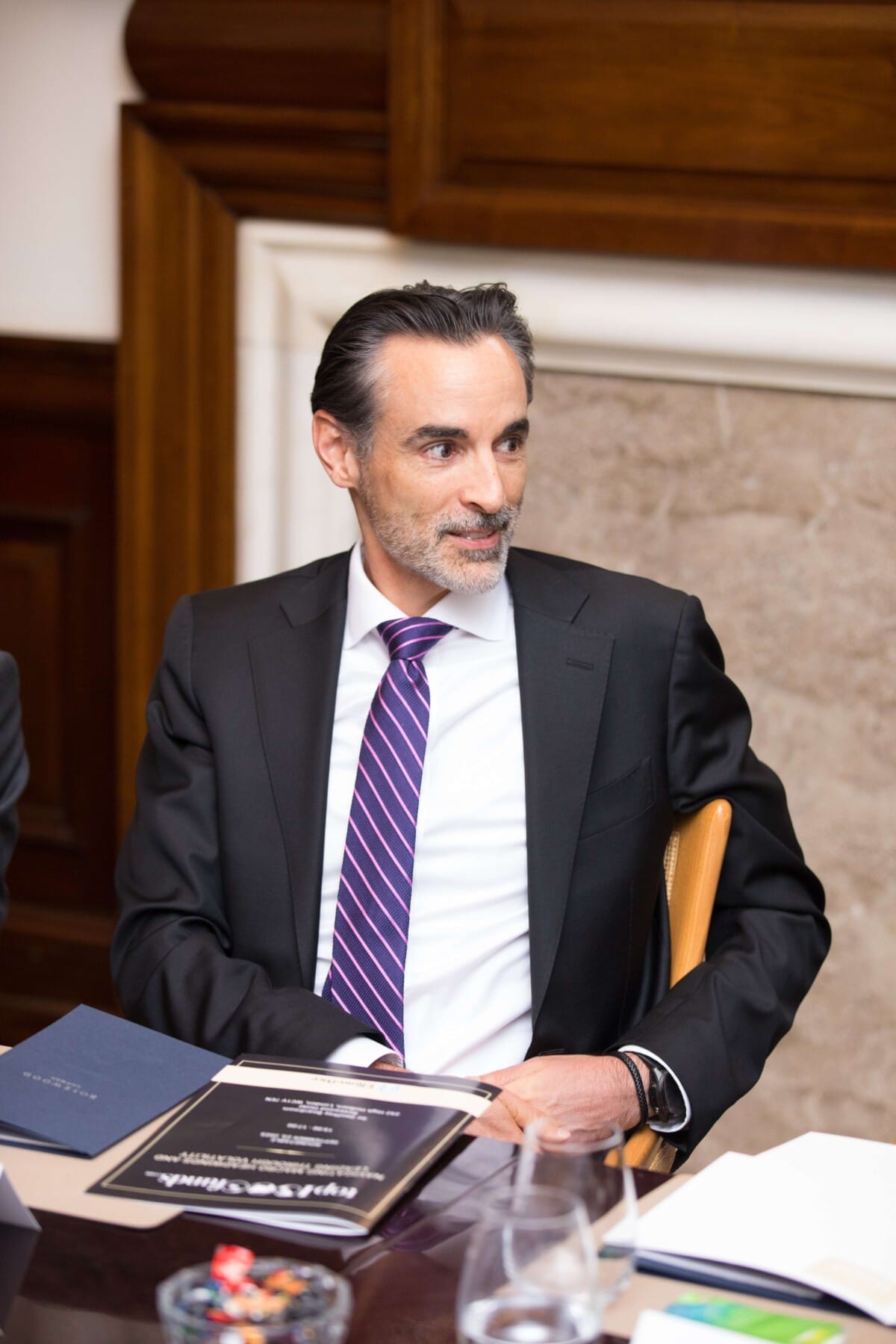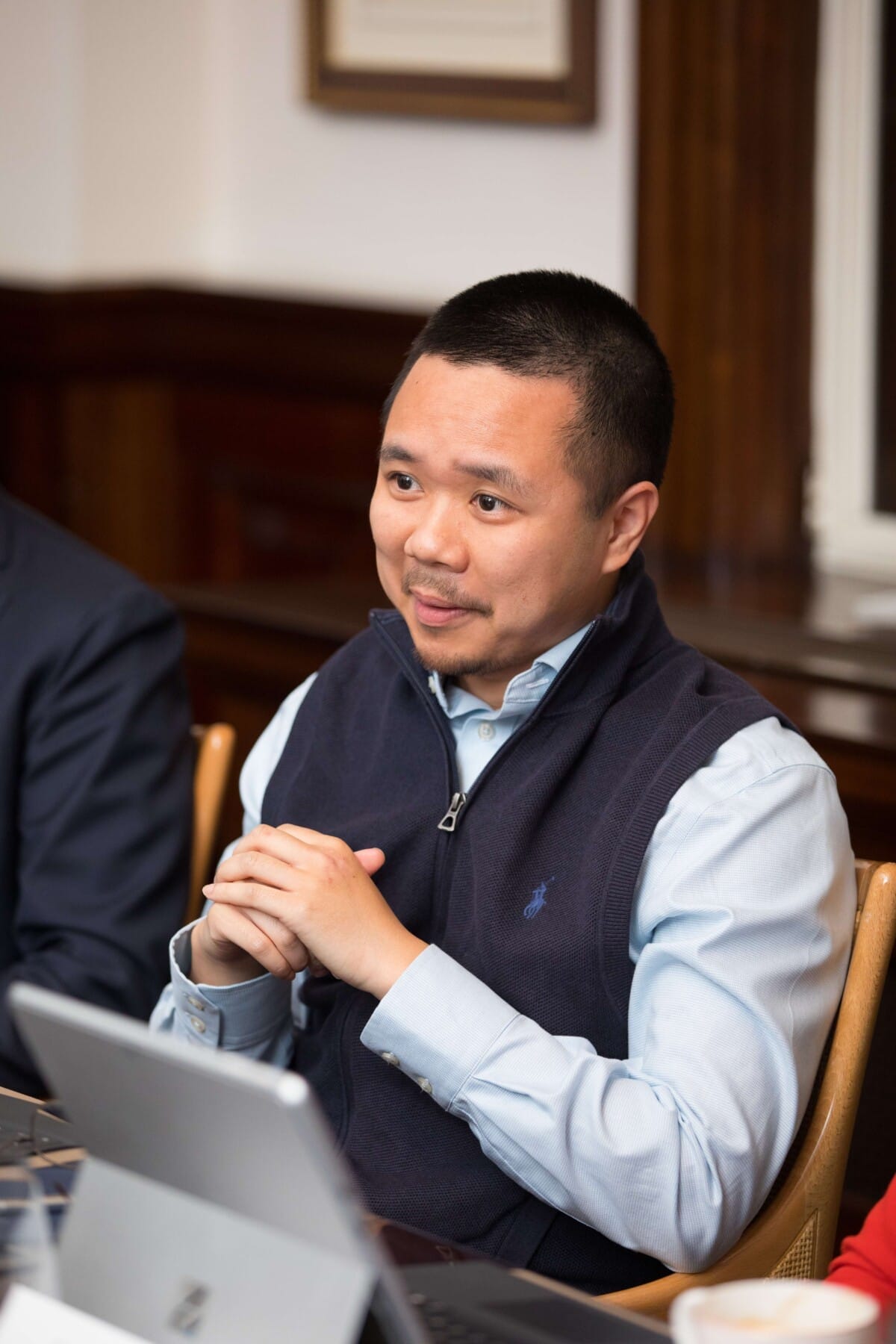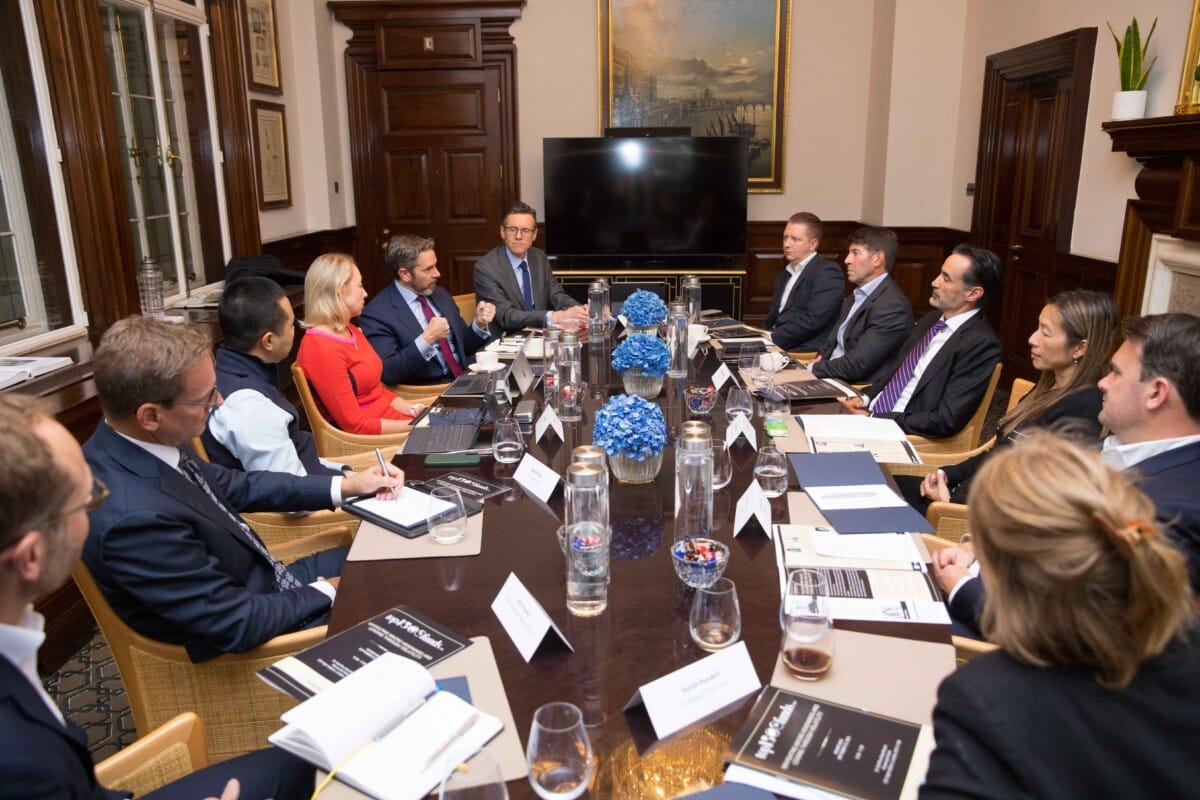Produced in partnership with T. Rowe Price
When global asset owners gathered at London’s historic Rosewood Hotel to gage market sentiment and explore investment strategies and ideas, the tone was remarkably upbeat in a conversation that spanned currency strategies, the muted impact of geopolitics on asset prices, and the importance of managing human bias.
It would be easy to believe today’s fraught geopolitics, shifting long-term themes and all the uncertainty inherent in the AI boom would mean investors are overwhelmingly cautious. But during a roundtable hosted by Top1000funds.com in partnership with T. Rowe Price the majority of attendees voiced cautious optimism for investment returns ahead.
Like Sébastian Page, chief investment officer and head of global multi-asset at T. Rowe Price who described his view of the US market as both optimistic and speculative. Sure, property prices are falling, household debt is mounting, and unemployment is up 90 basis points. Moreover, there has been no time in US history when unemployment has risen by this much and the country hasn’t slipped into a recession.
Yet he said looking through an optimistic lens, the Fed is cutting rates creating fiscal stimulus, corporate earnings are growing at around 12 per cent per annum, consumer spending is strong, and AI capex spending is expected to increase a further 80 per cent. This all supports rising GDP.

Inflation, over the last few months, has been about 3 per cent so, if the US is running at 6.3 per cent nominal growth, that is higher than any year between the GFC and Covid
In the same vein, Anna Stupnytska, head of long-term investment strategy at the £55 billion ($73.8 billion) UK workplace pension scheme, Nest, described the current investment climate as both “complicated” and “expensive,” but said she also remains positive about the US economy.
“The direction of monetary and fiscal policy is accommodating, and financial conditions are easing, so unless there is something else, like an external shock, this combination sets the scene for a really meaningful acceleration in the US,” she said.
For some, like John Greaves, director of total portfolio investments, at the £34 billion ($45.8 billion) UK defined benefit scheme Railpen the opportunity lies in assets with growth and inflation resilience – and by avoiding expensive tech stocks, even though they might offer higher, short-term returns.
“We need to earn around inflation plus 5 per cent over the long-term for our plans that are open to new members, and you can get 2 to 3 per cent real returns from UK government bonds now, so it’s not so hard to find quality assets to do that in a baseline or upside scenario,” he reflected, adding that he sees “a lot of value” in the market outside technology, and “no need to chase assets.”
That’s not to say he doesn’t have an eye on the portfolio’s vulnerabilities. “An investment strategy might broadly deliver on its objectives 90 per cent of the time but it’s that 10 per cent where there might be meaningful shortfalls and [we’re] thinking about what that looks like,” he said.
Nor do seasoned investors believe the AI financing boom is necessarily about to turn to bust. John Normand, head of investment strategy at the A$387 billion ($255.7 billion) defined contribution fund AustralianSuper voiced concerns that what started out as a “great idea and wonderful investment theme” could become “overcooked” due to the possibility of overly loose monetary policy under the incoming Federal Reserve chair.
“My fear is that this could all end in tears at some point in the distant future and it’s probably going to have, as its roots, a typical thematic that attracts investors, and monetary policy that is inappropriate for the supply side of the economy,” he said.
Still, he’s not making any moves to de-risk just yet.
“It is possible markets are about half-way into an AI bubble, but not as far as two-thirds of the way in,” he reflected. “If I thought it was two-thirds, I wouldn’t want exposure to the AI theme in a variety of ways including being reasonably overweight equities in general because it wouldn’t be possible for that AI bubble to deflate without taking down stocks broadly,” he said.
“My fear is that this could all end in tears at some point in the distant future and it’s probably going to have, as its roots, a typical thematic that attracts investors, and monetary policy that is inappropriate for the supply side of the economy,” he said.
Still, he’s not making any moves to de-risk just yet.
“It is possible markets are about half-way into an AI bubble, but not as far as two-thirds of the way in,” he reflected. “If I thought it was two-thirds, I wouldn’t want exposure to the AI theme in a variety of ways including being reasonably overweight equities in general because it wouldn’t be possible for that AI bubble to deflate without taking down stocks broadly,” he said.
Geopolitics isn’t impacting asset prices as much as we think
In another argument for optimism, geopolitical uncertainty is not necessarily negatively influencing asset prices. Witness the subdued impact of the Trump administration’s Liberation Day announcements and tariffs on imports to the US, T. Rowe Price’s Page said.
“If you fell into a deep sleep in February 2022 and woke up today, and I told you about everything that had happened since then including all the conflicts, inflation and tariffs, you’d probably be surprised to learn that the [US] market is up 45 per cent,” he said.
Like other investors Nest has an extensive scenario analysis that included undertaking a review of the impact of some of the key geopolitical risks on the portfolio over the next three-to-five years. The results were similarly unexpected, said Stupnytska.
“The world is very different today so the approach that we’re taking is to look at different scenarios, and one of the risks that is very difficult to assess is the changing geopolitical order and where it ultimately moves to.”
For other investors, analysis of the business cycle is another source of reassurance in what lies ahead.
Despite heightened volatility and market uncertainty, AustralianSuper’s Normand believes the business cycle remains near trend.
“The negatives in terms of tariffs are being neutralised by positives such as fiscal stimulus and Fed easing,” he said. “It creates winners and losers, and inter-quarter volatility, but when I analyse the wide range of issues, I try to reduce it to whether any of it is going to fundamentally affect the pace of the business cycle.”
The findings, he said, don’t flag any reason for alarm just yet, and even if growth shifts down a gear for a quarter, he won’t be unduly concerned.
“I don’t see all these issues as all that destabilising for the trend rate of growth of the economy,” he said, with one cautionary note: the business cycle is also at the mercy of US policy makers, currently pulling on the levers that control labour supply. Nor is it clear if a potentially tighter labour market can be offset by long-term productivity gains from AI.
Concerns that the US jobs market could trigger economic woes down the line was also flagged by other investors in the room.
It’s one reason why Mike Liu, head of markets and research at Coal Pension Trustees Services which oversees around £20 billion ($26 billion) in assets on behalf of beneficiaries in two schemes from the UK’s legacy coal industry, is seeking to diversify away from the US in a contrarian view.

Any nominal [increase in] stimulus might translate into higher inflation than real economic growth, making it a possibility that growth may dip below 2 per cent next year,
Liu is not concerned about the US nominal GDP growth, which is higher than most European countries, but he is worried about the amount of fiscal stimulus amid near zero growth in US labour supply.
“Any nominal [increase in] stimulus might translate into higher inflation than real economic growth, making it a possibility that growth may dip below 2 per cent next year,” he said. “At the same time, you’ve got inflation at around 3 per cent. Above-target inflation and below-potential growth is not a very good environment for investments and that’s the risk.”
Strategies in the current climate
Investors are positioning their portfolios in a variety of ways in response to today’s opportunities. For some, currency strategies have edged front of mind.
For example, Alex Shaw, managing director, trading, at the C$731.7 billion ($524.4 billion) CPP Investments explained that the fund’s foreign exchange and currency management strategy has changed in recent years in pursuit of greater diversification benefits and higher risk-adjusted returns.
From zero hedging four years ago, the group, which has 88 per cent assets invested outside Canada, currently hedges around 20 per cent of its portfolio. “Where FX risk is uncompensated, we can take more equity risk by hedging it, and we believe 20 per cent is the optimal level for us.” Shaw said.
Australia’s third largest superannuation fund, Aware Super, is also rethinking its position on currency hedging, particularly as the fund invests more offshore, said Damien Webb, deputy chief investment officer.
“When markets fall, the Aussie dollar tends to fall so being unhedged is usually a low-cost buffer because you get returns in an unhedged way, but that hasn’t always been the case recently,” he said.
Elsewhere, Railpen has also recently increased its currency hedging, and now has about a third non-sterling FX risk for the schemes that are open to new members. “By being really clear and aligned on our horizon, we actually got comfortable with the idea of increasing our currency hedging a little,” said Greaves.
But he explained that the strategy depends on the different mandates of the funds under Railpen’s umbrella. Ultimately, decisions on portfolio construction, including currency hedging, come back to purpose, objectives and timeframes of the underlying fund, he said.
“We just completed a piece of work to get really aligned on our mandate and the time horizon for constructing and managing the investments because we were having a lot of discussions about things like commodities and currency hedging and it kept coming back to the mandate,” he said. “Some have a reference portfolio, some have an absolute return objective, and some have peer group benchmarking, I think that context is very important to answer a lot of these portfolio construction questions because obviously, if you have a shorter-term horizon, or need to be benchmark-aware, you approach some of these things differently.”
T. Rowe Price is bearish on the US dollar but does not run active overlays on its equity portfolios. Its views on currency are expressed through its fixed income portfolio, explained Page. “We have active overlays as a source of alpha within fixed income portfolios and at the asset allocation level, it’s more macro.”
As for other T. Rowe Price strategies, looking six-to-12 months ahead Page said the firm has a neutral position on stocks and bonds. “The fundamentals are fine, if not good, but valuations are elevated, which ends up neutral,” he said. “We’re short duration and positioned for inflation to go higher than expectations. We’re also long diversification – for example, we have overweight positions in international value stocks.”
In contrast, other investors are deliberately avoiding short, and even longer term, macroeconomic factors in their decision making. Like John Dewey, chief investment officer at the £20 billion West Yorkshire Pension Fund. In the absence of a high degree of conviction either way on how markets might act in the future, he is wholly focused on the job of paying long term pensions.
“I have a very broad portfolio of assets and when I look at things like credit spreads and risk-free rates today, I feel there are much easier decisions for me to make than [analysing] short-term or even longer-term macroeconomic factors,” he said.
“We have sterling liabilities, and we pay our members sterling payments long into the future. We can get UK-government backed cashflow at around 5.5 per cent yield and 2.5 per cent real yield, and when I look at US non-financial credit spreads, they haven’t been this low for decades. I weigh portfolio decisions in proportion to my conviction and at the moment, I have very low conviction.”
Cindy Chan, head of first-line investment risk at the £31 billion ($41.7 billion) Pension Protection Fund, the lifeboat fund that protects the pensions of eligible DB schemes when sponsors become insolvent, described global markets as “uncertain and tricky.”
But she said the PPF is better positioned now to navigate uncertainty ahead following a 2023 decision to decouple the PPF’s liability hedging assets from the non-hedging assets. Effectively creating two portfolios has helped decision making, said Chan.
“We also have a separate growth portfolio with a certain target return and risk budget. Having two portfolios with different objectives and different time horizons has made it easier to focus our investment decisions. The growth portfolio is structured to focus on delivering the long-term return that we want to generate and we’re able to make the right decisions for the right time horizon, which is very important.”
Tools for success
Repeatable processes and focused decision-making both sit high on the list of investment priorities in the current market.
For Page, a wariness of human bias in the way subjects are presented should also feed into decision making. “Every idea we might have on growth, on speculation, on whether markets are expensive or cheap can be presented in a way that’s framed to make a point. Every time you look at the financial media or politics or marketing, you’re looking at a certain amount of framing.”
Investors should ignore any urge to keep their money in cash – albeit that’s not really a possibility for the likes of Australia’s DC funds, subject to an annual performance test and peer comparison and typically fully or as close to fully invested at all times.
Page recalled a situation in April, when markets had plunged 20 per cent and recession forecasts jumped 66 per cent and a retail investor on one of T. Rowe Price’s webinars asked if he should sell everything and hold cash, given he was just five years off retirement.
“I said, don’t do that because while there are retail investors who have successfully bought a dip, there are more who have panicked and sold at the wrong time,” he said. “I always say, stay invested, stay diversified.”
Moreover, de-risking or seeking protection can come at the expense of missing out on the opportunities. When markets trade at record highs, there is a natural tendency for investors to focus heavily on downside protection yet “tectonic shifts” are creating opportunities, said Aware Super’s Webb, pointing again to AI.
“There are some really big things pulling us in a range of different directions and, to be frank, it is hard to know which way to break at this point. But our job is to stay in the market,” he said. “The asset managers that I consider leaders aren’t sitting in their bunkers, they’re out there making significant plays because they fundamentally believe that this is the big moment, almost like after the GFC, so while it’s a tricky time, there are a lot of opportunities and we’re certainly making sure that we stay invested.”
Other tools for success include using incentives to push staff to put total portfolio performance before individual asset class returns and leadership strategies that incorporate sports psychology whereby tweaks in the quest to go further or faster constantly add to, and fine tune a process.
The final ingredient for investors in the current climate? A good dose of luck.
The interplay between luck and skill is one of Scott Keller, chief executive officer, T. Rowe Price International’s favourite interview questions. Enthusiastic applications vying to join his 1000-plus team frequently overegg their skills, but luck also plays a vital role in success.
“I believe investment is a repeatable process: you need to do your research and do everything you are supposed to do,” he said. “But you need a little bit of luck too.”


